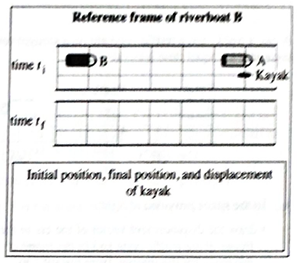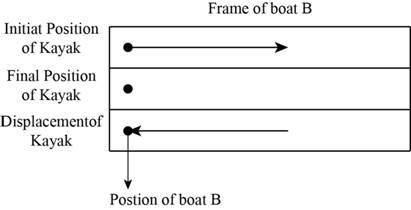
Concept explainers
Reference frame of boat B:
Complete the upper diagram at right by drawing and labeling boats A, B, and the kayak at their positions at time
In the space at lower right, draw and label vectors for the initial position, the final position, and the displacement of the kayak in the frame of boat B.
In the frame of boat B, is the speed of the kayak greater than, less than, or equal to the speed of boat A? Explain.

The position of boat A, B and kayak at time
Explanation of Solution
Introduction:
A frame of reference is a combination of coordinate
In frame of boat B, the speed of boat B is zero. Boat A and kayak will move in the left direction in frame of boat B.
The final position of boat A, boat B and in frame of boat B is shown in figure 1.

Figure 1
The initial position, final position and displacement of kayak are shown in figure 2.

Figure 2
The displacement of kayak is more than the displacement of boat A for same interval of time. So, the speed of kayak is greater than the speed of boat A in frame of boat B.
Conclusion:
Therefore, the position of boat A, B and kayak at time
Want to see more full solutions like this?
Chapter 15 Solutions
Tutorials in Introductory Physics
Additional Science Textbook Solutions
Cosmic Perspective Fundamentals
College Physics: A Strategic Approach (4th Edition)
Introduction to Electrodynamics
University Physics Volume 2
College Physics (10th Edition)
- I need help with part c, can you write out the sentence with the answer please, thank you.arrow_forwardHello, based on the table can you please help me do a, b and c?arrow_forwardA ball of mass m moving with velocity v⃗ i strikes a vertical wall as shown in (Figure 1). The angle between the ball's initial velocity vector and the wall is θi as shown on the diagram, which depicts the situation as seen from above. The duration of the collision between the ball and the wall is Δt , and this collision is completely elastic. Friction is negligible, so the ball does not start spinning. In this idealized collision, the force exerted on the ball by the wall is parallel to the x axis.What is the magnitude F of the average force exerted on the ball by the wall?arrow_forward
- I did a and b. So can you help me do and explain part c and d ?arrow_forwardAnswer Part B.Vectors x and y are moving with uniform velocities. If the image below is t = 0, how long will it take (in seconds) for vector x to be in the same position with vector y? How far should vector x have traveled (in meters) by the time it has overtaken the position of vector y? Show proper solution.arrow_forwardplease help: A rectangular painting is 112 cm wide and 77.4 cm high, as indicated below At what speed, v, must the painting move parallel to its width if it is to appear to be square? Express your answer to three significant figures.arrow_forward
- Derive a formula for the centroid of section U in the figure below, in terms of r and h and in relation to the x and y axesarrow_forwardCan you please show full derivation for Part B?arrow_forwardA jetliner has an air speed of 500 mph. A 200-mph wind is blowing fromwest to east.(a) The pilot heads due north. In what direction does the plane fly, and whatis its ground speed? (Hint: Define a frame of reference 5' that moves with the wind. In Sf there is no wind; hence the plane always moves in the direction it isheaded, at 500 mph. Use the velocity transformation to find the components ofthe plane's velocity in the ground frame.)(b) In what direction should the pilot head in order to fly due north? What isthe plane's ground speed in this case?arrow_forward
- Now find the components Nx and Ny of N in the tilted coordinate system of Part B. Express your answer in terms of the length of the vector N and the angle θ, with the components separated by a comma.arrow_forwardHello, based on the information provided can you please help me do the % error on the table in the rightarrow_forwardwhat is the solution to part c onlyarrow_forward
 College PhysicsPhysicsISBN:9781305952300Author:Raymond A. Serway, Chris VuillePublisher:Cengage Learning
College PhysicsPhysicsISBN:9781305952300Author:Raymond A. Serway, Chris VuillePublisher:Cengage Learning University Physics (14th Edition)PhysicsISBN:9780133969290Author:Hugh D. Young, Roger A. FreedmanPublisher:PEARSON
University Physics (14th Edition)PhysicsISBN:9780133969290Author:Hugh D. Young, Roger A. FreedmanPublisher:PEARSON Introduction To Quantum MechanicsPhysicsISBN:9781107189638Author:Griffiths, David J., Schroeter, Darrell F.Publisher:Cambridge University Press
Introduction To Quantum MechanicsPhysicsISBN:9781107189638Author:Griffiths, David J., Schroeter, Darrell F.Publisher:Cambridge University Press Physics for Scientists and EngineersPhysicsISBN:9781337553278Author:Raymond A. Serway, John W. JewettPublisher:Cengage Learning
Physics for Scientists and EngineersPhysicsISBN:9781337553278Author:Raymond A. Serway, John W. JewettPublisher:Cengage Learning Lecture- Tutorials for Introductory AstronomyPhysicsISBN:9780321820464Author:Edward E. Prather, Tim P. Slater, Jeff P. Adams, Gina BrissendenPublisher:Addison-Wesley
Lecture- Tutorials for Introductory AstronomyPhysicsISBN:9780321820464Author:Edward E. Prather, Tim P. Slater, Jeff P. Adams, Gina BrissendenPublisher:Addison-Wesley College Physics: A Strategic Approach (4th Editio...PhysicsISBN:9780134609034Author:Randall D. Knight (Professor Emeritus), Brian Jones, Stuart FieldPublisher:PEARSON
College Physics: A Strategic Approach (4th Editio...PhysicsISBN:9780134609034Author:Randall D. Knight (Professor Emeritus), Brian Jones, Stuart FieldPublisher:PEARSON





